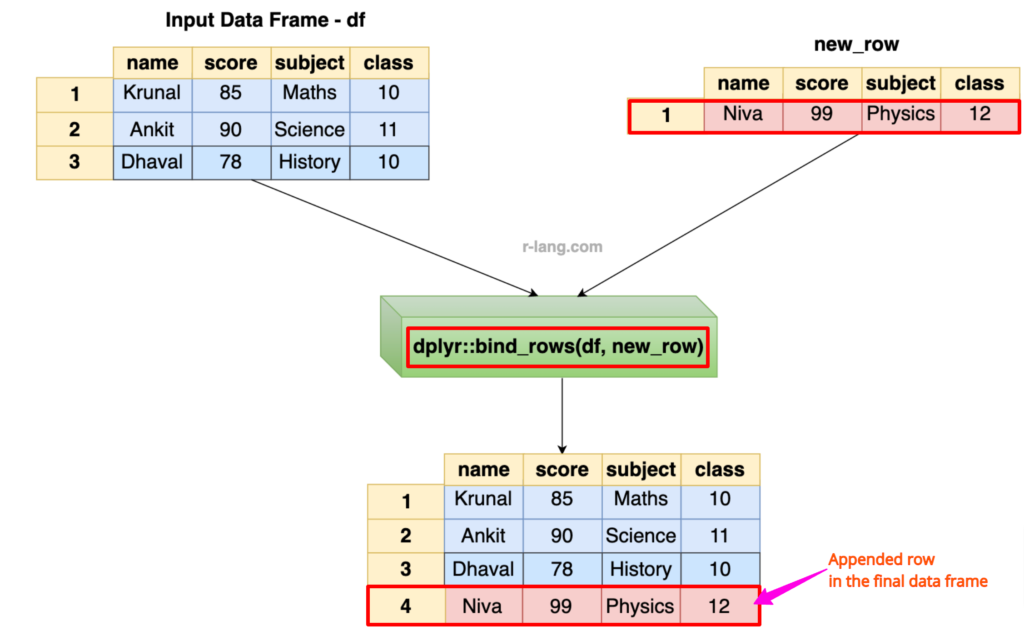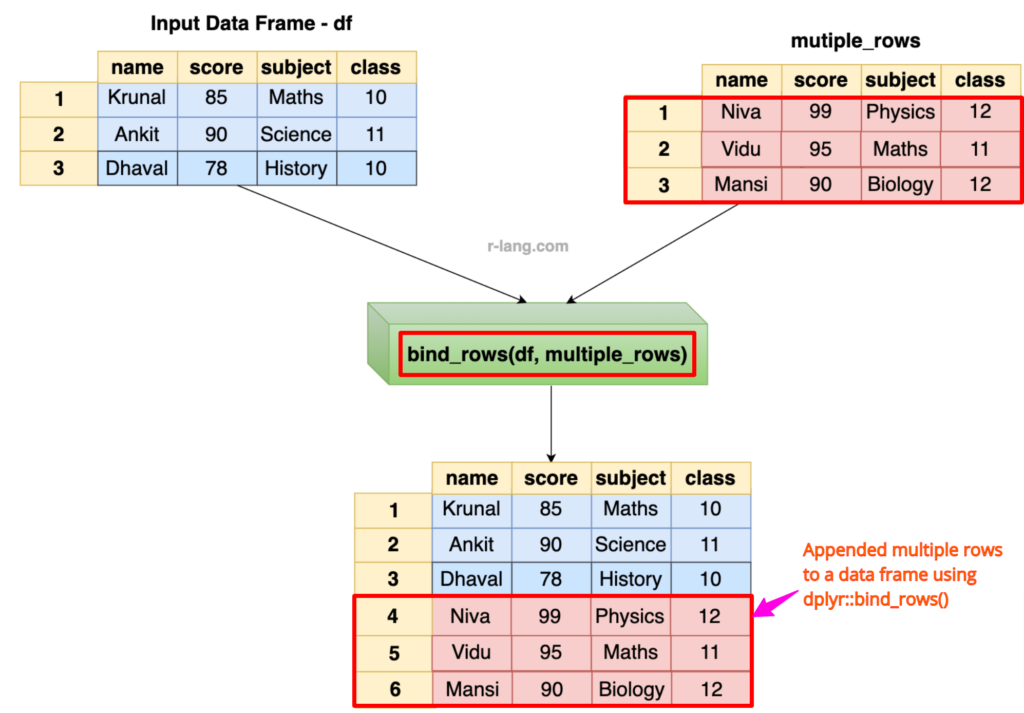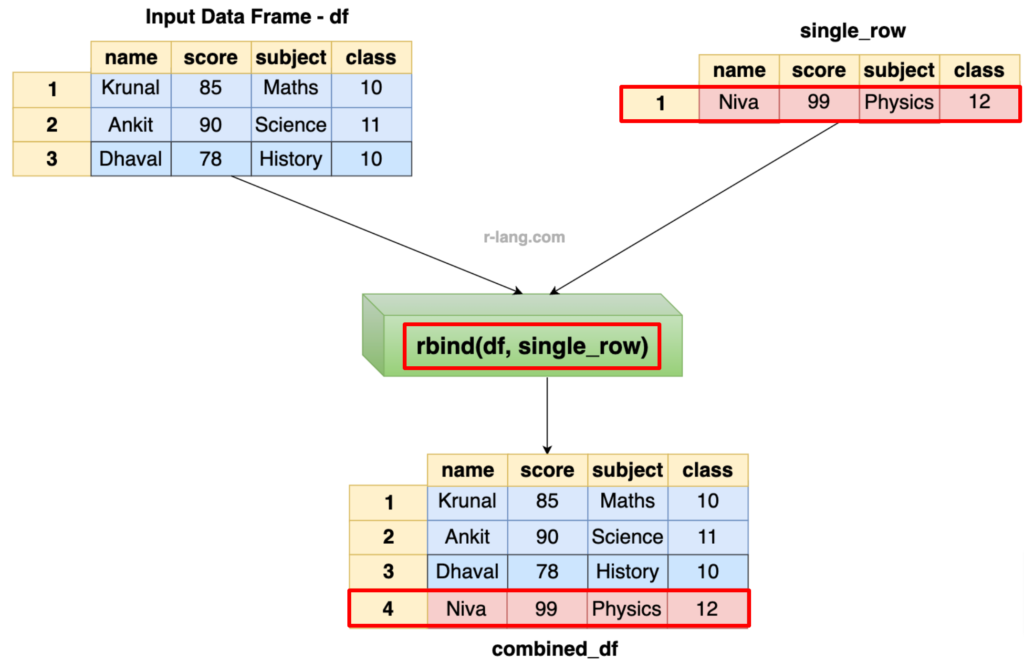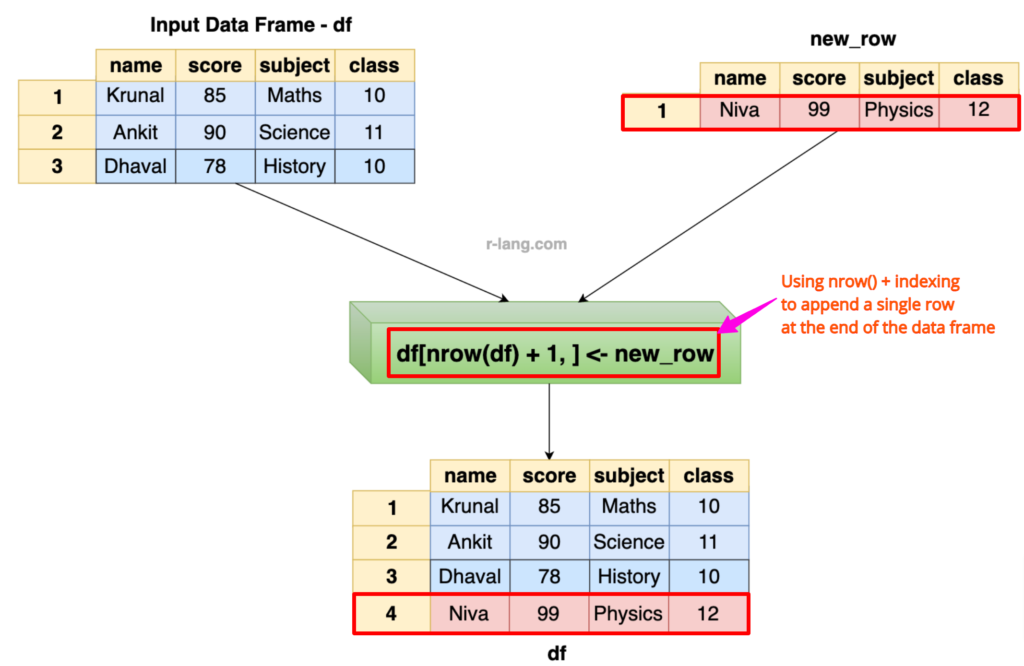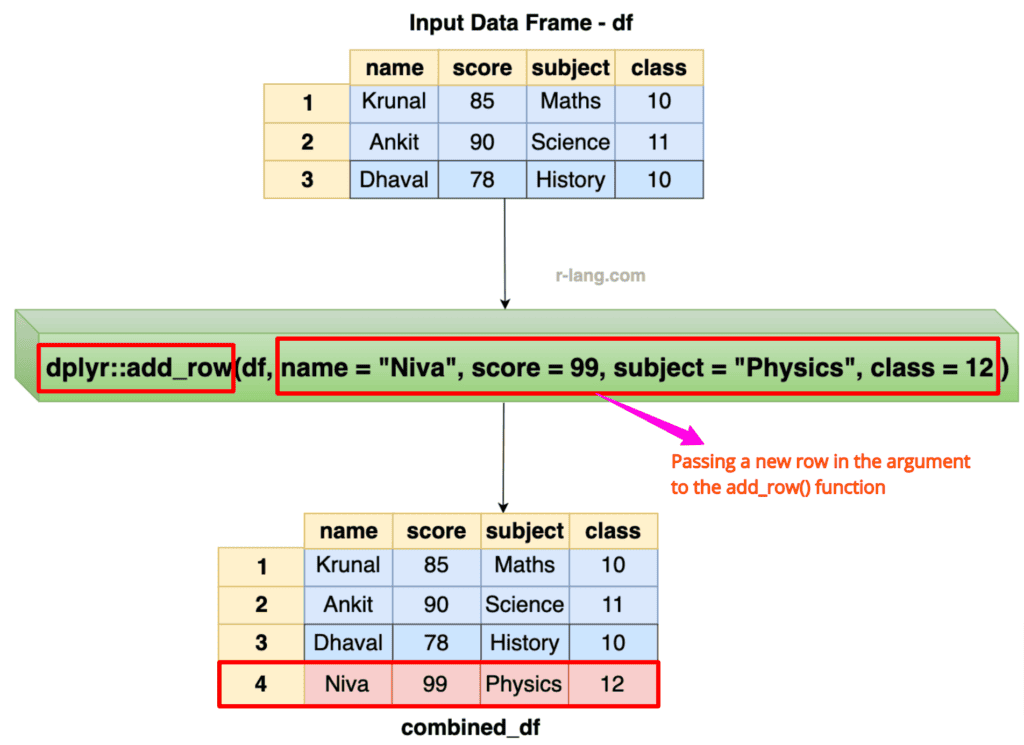Here are four ways to append rows to a data frame in R:
- Using dplyr::bind_rows() (Efficient Way)
- Using rbind()
- Using nrow()
- Using dplyr::add_row()
Method 1: Using dplyr::bind_rows()
The most efficient way to append a single or multiple rows to a data frame is to use the “dplyr::bind_rows()” function.
This function accepts a data frame and the rows to be appended and returns the combined data frame.
Appending a single row
When appending a single row, the data frame is updated to include a single row.
Pass that data frame to the bind_rows() function as a second argument.
library(dplyr)
df <- data.frame(
name = c("Krunal", "Ankit", "Dhaval"),
score = c(85, 90, 78),
subject = c("Math", "Science", "History"),
class = c(10, 11, 12)
)
new_row <- data.frame(
name = "Niva",
score = 99,
subject = "Physics",
class = 12
)
# Appending a single row using dplyr::bind_rows()
appended_df <- bind_rows(df, new_row)
print(appended_df)
Output
In the above output, you can see that the output data frame contains an appended row.
Appending multiple rows
Appending multiple rows means appending a data frame with multiple rows to your primary data frame, which the bind_rows() function efficiently does.
library(dplyr)
df <- data.frame(
name = c("Krunal", "Ankit", "Dhaval"),
score = c(85, 90, 78),
subject = c("Math", "Science", "History"),
class = c(10, 11, 12)
)
multiple_rows <- data.frame(
name = c("Niva", "Vidu", "Mansi"),
score = c(99, 95, 90),
subject = c("Physics", "Maths", "Biology"),
class = c(12, 11, 12)
)
# Appending multiple rows using dplyr::bind_rows()
appended_df <- bind_rows(df, multiple_rows)
print(appended_df)Output
You can see that, in just one step, we added multiple rows to an existing data frame using the dplyr::bind_rows() function effortlessly.
This approach is constructive when working with multiple data sources and files where column structures might vary.
Method 2: Using rbind()
The rbind() function is a base R function that can add single or multiple columns to a data frame, but the column names and the number of columns must match.
Appending a single row
The rbind() function works similarly to the bind_rows() function. It accepts the first argument as the primary data frame and the second argument as a data frame with a single row, binding both data frames row-wise and returning a combined single data frame.
df <- data.frame(
name = c("Krunal", "Ankit", "Dhaval"),
score = c(85, 90, 78),
subject = c("Math", "Science", "History"),
class = c(10, 11, 12)
)
single_row <- data.frame(
name = "Niva",
score = 99,
subject = "Physics",
class = 12
)
# Appending a single row using rbind() function
combined_df <- rbind(df, single_row)
print(combined_df)Output
Appending multiple rows
The process is the same: pass the first argument as your primary data frame and the second argument as a data frame with multiple rows.
The rbind() function combines the rows of both data frames and returns a single combined data frame.
df <- data.frame(
name = c("Krunal", "Ankit", "Dhaval"),
score = c(85, 90, 78),
subject = c("Math", "Science", "History"),
class = c(10, 11, 12)
)
multiple_rows <- data.frame(
name = c("Niva", "Vidu", "Mansi"),
score = c(99, 95, 90),
subject = c("Physics", "Maths", "Biology"),
class = c(12, 11, 12)
)
# Appending multiple rows using rbind()
appended_df <- rbind(df, multiple_rows)
print(appended_df)Output
Method 3: Using nrow()
The main functionality of the nrow() function is to return the number of rows of a data frame, but you can use it to append a row to the data frame with indexing.
df <- data.frame(
name = c("Krunal", "Ankit", "Dhaval"),
score = c(85, 90, 78),
subject = c("Math", "Science", "History"),
class = c(10, 11, 12)
)
new_row <- data.frame(
name = "Niva",
score = 99,
subject = "Physics",
class = 12
)
# Appending a single row using nrow() function
df[nrow(df) + 1, ] <- new_row
print(df)Output
As shown in the above figure, we utilize the nrow() function to determine the length of the data frame and add + 1 (the last index) to append a new row at the end of the data frame.
Using indexing, you can append a row to any index.
Method 4: Using dplyr::add_row() or tidyverse::add_row()
The dplyr::add_row() function intuitively adds rows to a data frame.
library(dplyr)
df <- data.frame(
name = c("Krunal", "Ankit", "Dhaval"),
score = c(85, 90, 78),
subject = c("Math", "Science", "History"),
class = c(10, 11, 12)
)
# Appending a single row using dplyr::add_row() function
combined_df <- add_row(df,
name = "Niva",
score = 99,
subject = "Physics",
class = 12
)
print(combined_df)Output
You can see that the add_row() function allows us to specify the values for each column directly within the function call.
That’s all!

Krunal Lathiya is a seasoned Computer Science expert with over eight years in the tech industry. He boasts deep knowledge in Data Science and Machine Learning. Versed in Python, JavaScript, PHP, R, and Golang. Skilled in frameworks like Angular and React and platforms such as Node.js. His expertise spans both front-end and back-end development. His proficiency in the Python language stands as a testament to his versatility and commitment to the craft.


